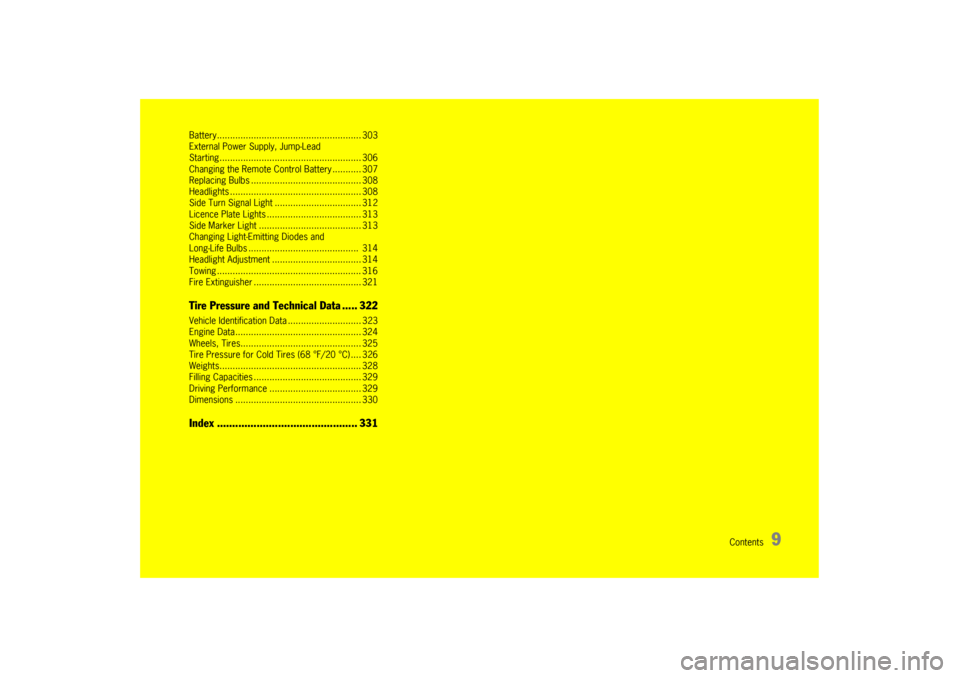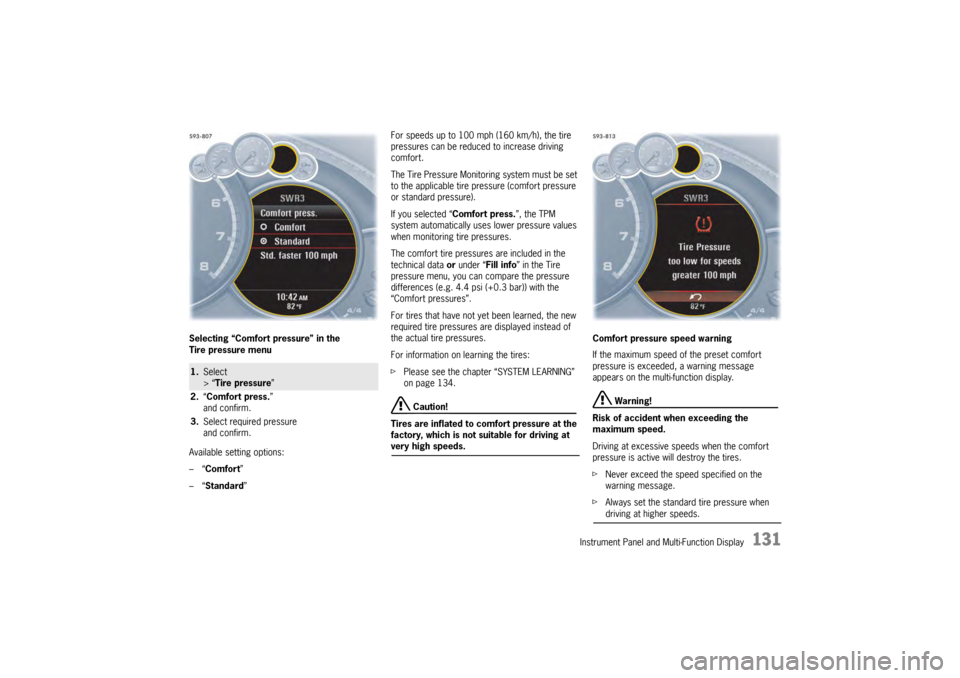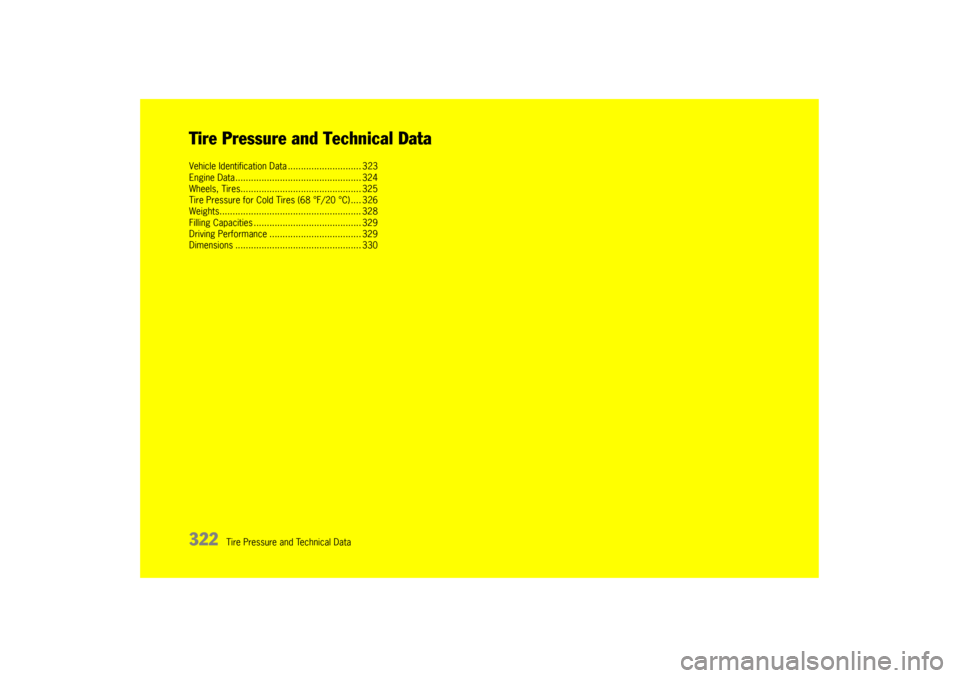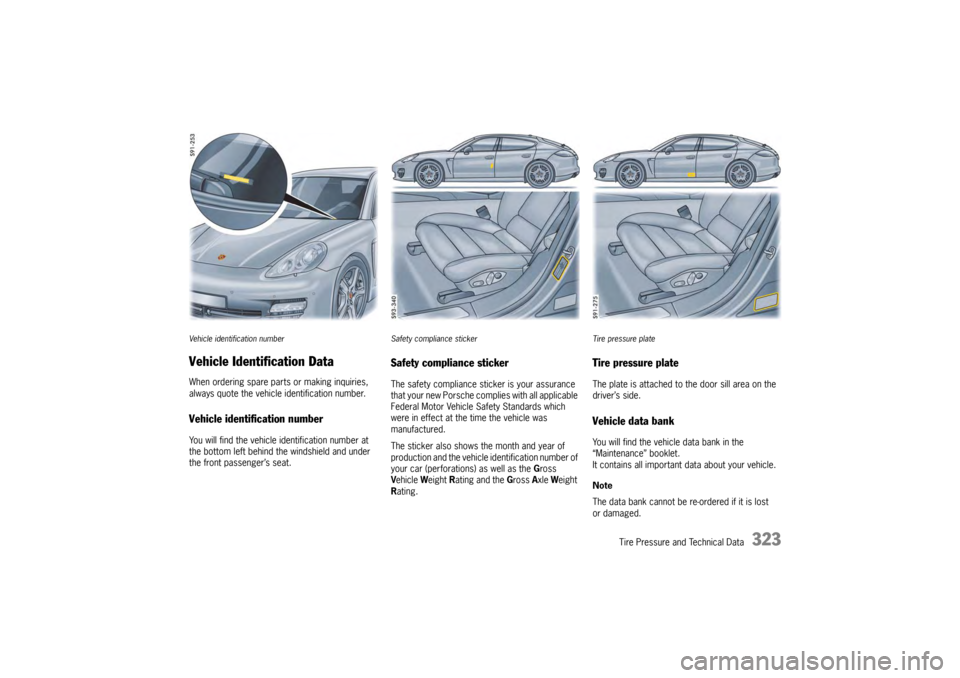technical data PORSCHE PANAMERA 2009 1.G Information Manual
[x] Cancel search | Manufacturer: PORSCHE, Model Year: 2009, Model line: PANAMERA, Model: PORSCHE PANAMERA 2009 1.GPages: 343, PDF Size: 7.96 MB
Page 11 of 343

Contents
9
Battery....................................................... 303
External Power Supply, Jump-Lead
Starting...................... ................................ 306
Changing the Remote Control Battery ........... 307
Replacing Bulbs .......... ................................ 308
Headlights ...................... ............................ 308
Side Turn Signal Ligh t ................................. 312
Licence Plate Lights .... ................................ 313
Side Marker Light ... .................................... 313
Changing Light-Emitting Diodes and
Long-Life Bulbs ........... ............................... 314
Headlight Adjustment .. ................................ 314
Towing ....................................................... 316
Fire Extinguisher ......... ................................ 321Tire Pressure and Technical Data ..... 322Vehicle Identification Data ............................ 323
Engine Data................................................ 324
Wheels, Tires.............. ................................ 325
Tire Pressure for Cold Tires (68 °F/20 °C) .... 326
Weights...................................................... 328
Filling Capacities ......... ................................ 329
Driving Performance ... ................................ 329
Dimensions .................... ............................ 330Index .............................................. 331
Page 133 of 343

Instrument Panel and Multi-Function Display
131
Selecting “Comfort pressure” in the
Tire pressure menu
Available setting options:
–“Comfort ”
–“ Standard ” For speeds up to 100 mph (160 km/h), the tire
pressures can be reduced to increase driving
comfort.
The Tire Pressure Monitoring system must be set
to the applicable tire pressure (comfort pressure
or standard pressure).
If you selected “
Comfort press.”, the TPM
system automatically uses lower pressure values
when monitoring tire pressures.
The comfort tire pressures are included in the
technical data or under “Fill info” in the Tire
pressure menu, you can compare the pressure
differences (e.g. 4.4 psi (+0.3 bar)) with the
“Comfort pressures”.
For tires that have not ye t been learned, the new
required tire pressures are displayed instead of
the actual tire pressures.
For information on learning the tires:
f Please see the chapter “SYSTEM LEARNING”
on page 134.
Caution!
Tires are inflated to comfort pressure at the
factory, which is not suitable for driving at
very high speeds. Comfort pressure speed warning
If the maximum speed of the preset comfort
pressure is exceeded, a warning message
appears on the multi-function display.
Warning!
Risk of accident when exceeding the
maximum speed.
Driving at excessive speeds when the comfort
pressure is active will destroy the tires.
f Never exceed the speed specified on the
warning message.
f Always set the standard tire pressure when driving at higher speeds.
1.Select
> “Tire pressure”
2. “Comfort press. ”
and confirm.
3. Select required pressure
and confirm.
Page 230 of 343

228
Storage, Luggage Compartment and Roof Transport System
Stowing Loads
Danger!
Danger of injury. An unsecured or incorrectly
positioned load can slip out of place or
endanger the vehicle occupants during
braking, direction changes or in accidents.
Never transport objects that are not secured.
f Always transport loads in the luggage
compartment, never in the passenger
compartment (e.g. on or in front of the seats).
f Support the load against the seat backrests
wherever possible. Always lock the backrests
into place.
f Only transport heavy objects with the rear seat
backrests upright and engaged.
f Place the load behind unoccupied seats
whenever possible.
f Stow heavy objects as far forward as possible
on the floor, with lightweight objects behind
them.
f Never load the vehicle higher than the top
edge of the seat backrest.
f Always protect the passenger compartment
with a luggage compartment cover. Do not
drive with objects on top of the luggage
compartment cover. f
If the rear seats are not occupied, the
backrests can be addition ally secured with the
seat belts. Simply cro ss the outer seat belts
and insert each into the opposite buckle.
f Make sure that the load cannot damage the
heating filaments and the TV antenna in the
rear window.
Tie-down belts
f Do not use elastic belt s or straps to tie
down a load.
f Do not route belts and straps over
sharp edges.
f Observe the directions for use and information
for the tie-down equipment.
f Use only belts with a tear strength of at least
1543 lbs (700 kg) and a maximum width of
1 in. (25 mm).
f Cross the belts over the load. Driving
f
Vehicle handling changes depending on the
vehicle load. Adapt your driving style to the
changed driving behavior.
f Do not exceed the maximum gross weight
and axle load.
This information can be found under “Technical
data” in this Owner’s Manual:
f Please see the chapter “WEIGHTS” on
page 328.
f Never drive with the tailgate open. Exhaust
gases can enter the passenger compartment.
f Adapt the tire pressure to the load.
After you change the tire pressure, you must
also update the setting for Tire Pressure
Monitoring.
For information on setting Tire Pressure
Monitoring on the multi-function display:
f Please see the chapter “OVERVIEW OF
WARNING MESSAGES” on page 152.
Information on tire pressures for partially and fully
loaded vehicles can be found under “Technical
data” in this Owner’s Manual:
f Please see the chapter “TIRE PRESSURE FOR
COLD TIRES (68 °F/20 °C)” on page 326.
Page 283 of 343

Minor Repairs
281
Treadwear
The treadwear grade is a comparative rating
based on the wear rate of the tire when tested
under controlled conditions on a specific
government test course. For example, a tire
graded 150 would wear one and a half (1-1/2)
times as well on the government course as a tire
graded 100. The relative performance of tires
depends upon the actual conditions of their use,
however, and may depart significantly from the
norm due to variations in driving habits, service
practices and differences in road characteristics
and climate.
Traction AA, A, B, C
The traction grades, from highest to lowest, are
AA, A, B, and C and they represent the tire's ability
to stop on wet pavement as measured under
controlled conditions on specified government
test surfaces of asphalt and concrete. A tire
marked C may have poor traction performance.
Warning!
The traction grade assigned to this is based
on braking (straight-ahead) traction tests
and does not include cornering (turned)
traction, acceleration, hydroplaning or peak
traction characteristics. Temperature A, B, C
The temperature grades are A (the highest), B and
C, representing the tire's resistance to the
generation of heat and it
s ability to dissipate heat
when tested under controlled conditions on a
specified indoor laboratory test wheel.
Sustained high temperatures can cause the
material of the tire to de generate and reduce tire
life, and excessive temperature can lead to
sudden tire failure.
The grade C corresponds to a level of
performance which all passenger car tires must
meet under the Federal Motor Vehicle Safety
Standard No. 109.
Grades B and A represent higher levels of
performance on the labora tory test wheel than the
minimum required by law.
Warning!
The temperature grade for this tire is
established for a tire that is properly inflated
and not overloaded. Excessive speed,
underinflation, or excessive loading, either
separately or in combin ation, can cause heat
buildup and possible tire failure, resulting
loss of control, leading to serious personal
injury or death.
Tire pressures
Danger!
Risk of accident.
Risk of serious personal injury or death.
Driving the vehicle with low tire pressure
increases risk of a tire failure and resulting
loss of control. Furthermore, low tire
pressure increases rate of wear of the
affected tires and cause damage.
f Always use an accurate tire pressure gage
when checking inflation pressures.
f Do not exceed the maximum tire pressure
listed on the tire sidewall. (Also refer to
”Technical data“).
f Please see the chapter “TIRE PRESSURE
PLATE” on page 283.
f Cold tire inflation pressure means: all tires
must be cold, ambient temperature maximum
68 °F (20 °C), when adjusting the inflation
pressure. Avoid sunlight striking the tires
before measuring cold pressures, since the
pressures would rise from temperature
influence.
Page 284 of 343

282
Minor Repairs
f
Valve caps protect the valve from dust and dirt,
and thus from leakage. Always screw caps
tightly down. Replace missing caps
immediately.
f Use only plastic valve caps.
f For safety reasons, don't use tire inflating
bottles.
f Please see the chapter “TIRE PRESSURE FOR
COLD TIRES (68 °F/20 °C)” on page 326.
Each tire, including the spare (if provided), should
be checked monthly when cold and inflated to the
inflation pressure recommended by the vehicle
manufacturer on the vehicle placard or tire infla-
tion pressure label. (If your vehicle has tires of a
different size than the size indicated on the vehicle
placard or tire inflation pr essure label, you should
determine the proper tire inflation pressure for
those tires).
As an added safety feature, your vehicle has been
equipped with a tire pressure monitoring (TPM)
that illuminates a low tire pressure telltale when
one or more of your tires is significantly under-
inflated. Accordingly, when the low tire pressure
telltale illuminates, you should stop and check
your tires as soon as po ssible, and inflate them to
the proper pressure. Driving on a significantly
under-inflated tire causes the tire to overheat and
can lead to tire failur e. Under-inflation also
reduces fuel efficiency an d tire tread life, and may
affect the vehicle’s handling and stopping ability. Please note that the TPM is not a substitute for
proper tire maintenance, and it is the driver’s
responsibility to maintain correct tire pressure,
even if under-inflation has not reached the level to
trigger illumination of the TPM low tire pressure
tell-tale.
For further information on the tire pressure
monitoring:
f
Please see the chapter “TIRE PRESSURE
MONITORING (TPM)” on page 127.
When tires are warm, the tire pressure is
increased.
f Never let air out of hot tires. This could cause
the tire pressure to fall below the prescribed
value.
Insufficient tire pressure can cause tires to over-
heat and thus be damaged – even invisibly. Hidden
tire damage is not eliminated by subsequently
correcting the tire pressure. Overloading
Danger!
Risk of damage to vehicle parts, loss of
control and serious pers onal injury or death.
f Do not overload your vehicle. Be careful about
the roof load.
f If you plan to load the vehicle, first correct the
tire pressure. Tire pressure for loaded vehicle
can be found on the tire pressure plate and in
the chapter technical data.
f Never exceed the specified axle load.
Overloading can shorten the service life of the
tires and car, as well as lead to dangerous
vehicle reactions and long braking distances.
Damage due to overloading is not covered by
the vehicle warranty.
Tire damage may also be caused by
overloading, and this damage is not covered by your tire warranty.
f Please see the chapter “LOADING INFORMA-
TION” on page 236.
Page 324 of 343

322
Tire Pressure and Technical Data
Tire Pressure and Technical DataVehicle Identification Data ............................ 323
Engine Data................................................ 324
Wheels, Tires.............. ................................ 325
Tire Pressure for Cold Tires (68 °F/20 °C) .... 326
Weights...................................................... 328
Filling Capacities ......... ................................ 329
Driving Performance ... ................................ 329
Dimensions .................... ............................ 330
Page 325 of 343

Tire Pressure and Technical Data
323
Vehicle identification numberVehicle Identification DataWhen ordering spare parts or making inquiries,
always quote the vehicle identification number.Vehicle identification numberYou will find the vehicle identification number at
the bottom left behind the windshield and under
the front passenger’s seat.
Safety compliance stickerSafety compliance stickerThe safety compliance sticker is your assurance
that your new Porsche complies with all applicable
Federal Motor Vehicle Safety Standards which
were in effect at the time the vehicle was
manufactured.
The sticker also shows the month and year of
production and the vehicle identification number of
your car (perforations) as well as the Gross
V ehicle Weight Rating and the Gross Axle Weight
R ating.
Tire pressure plateTire pressure plateThe plate is attached to the door sill area on the
driver’s side.Vehicle data bankYou will find the vehicle data bank in the
“Maintenance” booklet.
It contains all important data about your vehicle.
Note
The data bank cannot be re-ordered if it is lost
or damaged.
Page 326 of 343

324
Tire Pressure and Technical Data
Engine Data
Panamera SPanamera 4S Panamera Turbo
Engine type M 4820M 4840 M 4870
Number of cylinders 88 8
Displacement 293.3 cu. in. (4806 cm
3) 293.3 cu. in. (4806 cm
3) 293.3 cu. in. (4806 cm
3)
Max. engine output
as per 80/1269/EEC 400 hp (294 kW)
400 hp (294 kW) 500 hp (368 kW)
At engine speed 6500 rpm6500 rpm 6000 rpm
Max. torque
as per 80/1269/EEC 370 ftlb. (500 Nm) 370 ftlb. (500 Nm) 518 ftlb. (700 Nm)
(overboost 570 ftlb. (770 Nm))
At engine speed 3500–5000 rpm3500–5000 rpm 2250–4500 rpm
(overboost
2500–4000 rpm)
Engine oil consumption up to 1.6 quarts/621 miles
up to 1.5 l/1000 km up to 1.6 quarts/621 miles
up to 1.5 l/1000 km up to 1.6 quarts/621 miles
up to 1.5 l/1000 km
Maximum permitted engine speed 6700 rpm6700 rpm 6700 rpm
Page 327 of 343

Tire Pressure and Technical Data
325
Wheels, TiresfApproval of tire and wheel sizes is grante d based on extensive testing. Your authorize d Porsche dealer will be pleased to advise you about the current
approval status.
By fitting tires that have been approved by Porsche, you can be sure that you have the best possible tires for your Porsche.
The load capacity coefficient (e.g. “105 ”) and code letter (e.g. “V”) for permitted top speed are minimum requirements.
When fitting new tires or changing tires: Please see the chapter “TIRES AND WHEELS” on page 280.
f Snow chain clearance can only be guaranteed for the tires marked
1). Snow chains can only be fitted on the rear wheels. Maximum speed
30 mph (50 km/h). Only use fine-link cross-ty pe or edge chains approved by Porsche.
Panamera S, Panamera 4S Panamera Turbo
18-inch wheel front axle/rear axle
8J x 18, Rim offset 59 mm/9J x 18, Rim offset 53 mm
Summer tires front axle/rear axle
245/50 ZR 18 (100Y)/275/45 ZR 18 (103Y)
Snow tires front axle/rear axle
245/50 R 18 100V/275/45 R 18 103V
1)
19-inch wheel front axle/rear axle 9J x 19, Rim offset 60 mm/
10J x 19, Rim offset 61 mm 9J x 19, Rim offset 60 mm/
10J x 19, Rim offset 61 mm
Summer tires front axle/rear axle
255/45 ZR 19 (100Y)/285/40 ZR 19 (103Y) 255/45 ZR 19 (100Y)/285/40 ZR 19 (103Y)
Snow tires front axle/rear axle
255/45 R 19 100V/285/40 R 19 103V
1)
255/45 R 19 100V/285/40 R 19 103V
1)
20-inch wheel front axle/rear axle 9.5J x 20, Rim offset 65 mm/
11J x 20, Rim offset 68 mm 9.5J x 20, Rim offset 65 mm/
11J x 20, Rim offset 68 mm
Summer tires front axle/rear axle
255/40 ZR 20 (101Y) XL/295/35 ZR 20 (105Y) XL 255/40 ZR 20 (101Y) XL/295/35 ZR 20 (105Y) XL
20-inch wheel front axle/rear axle 9.5J x 20, Rim offset 65 mm/
10.5J x 20, Rim offset 65mm 9.5J x 20, Rim offset 65 mm
/
10.5J x 20, Rim offset 65 mm
Snow tires front axle/rear axle
255/40 R 20 101V XL/285/35 R 20 104V XL
1)
255/40 R 20 101V XL/285/35 R 20 104V XL
1)
Page 328 of 343

326
Tire Pressure and Technical Data
Danger!
Installation of size s not authorized by
Porsche may have a dangerous effect on
the driving stability and could result in
serious personal injury or death.
f Before mounting new tires check with your
Porsche dealer about the current releasestatus.
Tire Pressure for Cold Tires (68 °F/20 °C)These standard and comfort tire pressures apply only to the tire makes and types approved by Porsche.Standard tire pressure for summer, winter and all-season tiresfThe load condition of the vehicle must be set on the multi-function display. The tire pressure must be changed according to the vehicle load.
Please see the chapter “SELECTING “CHARGE” IN THE TIRE PRESSURE MENU” on page 130.FA = front axle, RA = rear axle
Panamera S, Panamera 4S Panamera Turbo
Part load Full loadPart load Full load
FA RA FA RA FA RA FA RA
18-inch wheels 37 psi
(2.5 bar) 37 psi
(2.5 bar) 37 psi
(2.5 bar) 43 psi
(2.9 bar)
19-inch wheels 37 psi
(2.5 bar) 37 psi
(2.5 bar) 37 psi
(2.5 bar) 43 psi
(2.9 bar) 40 psi
(2.7 bar) 37 psi
(2.5 bar) 40 psi
(2.7 bar) 40 psi
(2.7 bar)
20-inch wheels 40 psi
(2.7 bar) 37 psi
(2.5 bar) 41 psi
(2.8 bar) 44 psi
(3.0 bar) 43 psi
(2.9 bar) 37 psi
(2.5 bar) 44 psi
(3.0 bar) 44 psi
(3.0 bar)